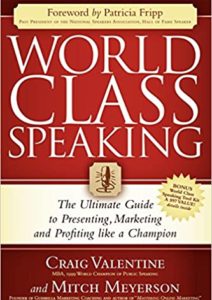Imagine my surprise when the national sales manager said to 60 of his top associates, “At lunch the sales team and I decided we have no idea how we managed to sell anything before we met Patricia.” He told me, “It takes a year for us to have the opportunity to deliver an hour presentation to a small group of executives from the company of one of our prospects. At that point a new relationship is worth between $5 and 10 million dollars to our company.”
I asked, “How long do you spend rehearsing a presentation that important?”
What I expected Dan to say was, “We spend a week locked in the boardroom. We go over the presentation multiple times, we video and review our performance. At least three times we bring in different associates to fire tough questions at us.”’
Instead he said, “If we have a run-through in the back of Joan’s car, we are lucky.”
This is disgusting. Remember what Oscar winner Sir Michael Caine said: “Rehearsal is the work; performance is the relaxation.”
It is common practice for companies in all industries to invest time and money making sure their sales associates know all about their territories, the company history, the products they sell, and their competitive marketing place. They often stop short in preparing their associates to design and deliver persuasive sales presentations that focus on what their prospects are interested in hearing.
Before you invest the appropriate time in rehearsing your presentation, make sure your presentation structure and focus are right. Here are the 4 more common mistakes that I see on the sales stage and what you can do to avoid them:
1. Unclear Thinking. Want clarity? Imagine that a busy executive says, “You have exactly ten minutes to tell me what you want me to know about your company.” At any stage of the sales process, you should know in advance what your prospect is really asking. The real question is, “What do I need to know about how your company can improve our company? Will your products or services solve a problem, create new opportunities, increase savings, maximize earnings, simplify our processes, develop our human capital, or increase market share?” At this point, the executive is more interested in his company than he is in yours. Accomplish this, and you have the opportunity to present your options more formally.
2. Talking Too Much. The key to connecting with a client is conversation and asking questions. The quality of client information received depends on the quality of your questions, as well as waiting for and listening to the answers! A successful encounter early in the sales process should probably consist mostly of open-ended questions, the kind that require essay answers rather than just yes or no. And never rush on with preprogrammed questions that indicate you have paid no attention to the answer you just received!
Your job is to work closely with the team or champion who will give you information. Do your research so that your questions about their company are well thought out. Do not be afraid to go deeper. If they want to increase sales, ask, “By how much?” “In the same market or expanding to a new one?” Do they want to improve morale? Ask, “What are the signs that make this a priority?” “What have you done before?” “How great a success has it been?” Will they be upgrading technology? Ask, “How long have you been investigating options?” You need to determine whether they are interested or desperate.
3. Wrong Structure. To keep senior leadership or a prospect interested, you have to prove this premise: “Your company’s condition will be dramatically improved when you do business with us.”
Your talking points and presentation structure will be better received if they are not structured around your company. The “This is who we are, what we do, our unique methodology, and whom we do business with” conversation or presentation outline is not likely to get you very far. Use all the information you received from your questions to help them know you were listening. Structure the conversation or presentation around their interests, challenges, or opportunities.
Put as many of their words as possible into your presentation. Your prospects will not disagree with themselves. Yes, you will be talking about your company, your satisfied clients, and what is unique about you as a way to prove that you can appeal to what they are interested in, solve their challenges, and maximize their opportunities.
4. No Memorable Stories. People rarely remember your exact words. Instead, they remember the mental images your words inspire. Support your key points with vivid, relevant, client success stories. Help them see a movie in their minds by using your satisfied clients as memorable characters. What was their starting situation? Their problem and one your prospect can relate to? How are their results since you worked with them?
The best stories are third-party endorsements that have your clients using much more glowing statements than you could. Endorsement stories should be like a good Hollywood movie: memorable characters that your prospects can identify with, vivid dialogue, and a dramatic lesson about the benefits of doing business with you. When telling those client stories, give them a back story, add drama, and use actual dialogue that has been edited. Director Alfred Hitchcock said, “A movie is like life with all the dull parts left out.”
When the Vice President of Sales first called, he said, “Help. We heard you are the right person (or company) to help us solve . . . .” Always use the client’s words.
What we did was . . . . Here you insert the solution or methodology your prospect is most likely interested in. This can be delivered in your own words.
The success is also presented in the prospect’s words. “If John were here, he would say, ‘We would not have believed it possible that we could have . . . . You can’t go wrong choosing this company.’”
Now you are better prepared for a good rehearsal.














Comments